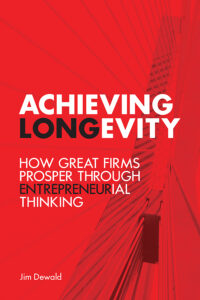Develop an Entrepreneurial Mindset
Why are some businesses more vulnerable to disruptive change than others?
Should big companies engage in entrepreneurship?
How do you stay ahead of the competition?
In Achieving Longevity: How Great Firms Prosper Through Entrepreneurial Thinking, Jim Dewald provides advice on how to create a culture of entrepreneurial thinking. He offers a method to combine the strength of a strong, established business with the innovation of a startup.
Jim is the Dean of the Haskayne School of Business at the University of Calgary, a former CEO and entrepreneur.
Prepare Yourself for Real Disruptive Change
What makes businesses vulnerable to disruptive change?
There are 2 main messages in my book.
First, that while we think the world is changing rapidly, in fact, we continue to rely on a platform that arose from the invention of 3 general purpose technologies in the 1870’s: the internal combustion engine, the light bulb, and the telephone. Even with the computer and the Internet, we have spent decades boxing in this amazing new technology to fit our paradigm need for a faster, smaller, cheaper phone. So, while we think we are in the midst of rapid change, the western world is in fact obsessed with ensuring we stick with the old world and reward refinements of tired mature ways of doing things. When real change comes, will business leaders be prepared? I don’t think so.
One of the reasons why we won’t respond well when real change comes is that while ideas are abundant, small start-up ventures lack the resources – people, money, physical assets — to launch these ideas. They also lack the credibility, networks, access to customers, suppliers, government officials, etc. This limits their ability to move these ideas forward, no matter how great they may be. At the same time, existing companies are flush with people, money, networks, customers, and, most important, credibility and brand value. But what they lack is an entrepreneurial mindset. To move forward, companies need to resist the rhetoric of finding and sticking to a narrow form of sustainable competitive advantage, and instead adopt a model of strategic entrepreneurship that promotes transformational growth and longevity.
The fundamental impact of disruptive change is that our organizations are not built to manage change very well. Through principles such as sustainable competitive advantage, we tend to use fixed mindsets that build a sort of impenetrable armor around the firm’s processes and procedures, instead of being flexible and adaptable. When disruptive technologies or business models present an alternative, firms resist. Indeed, even customers often resist, as we remain stuck in our paradigms formed as noted above. However, in time, customers adapt because they do not have the level of sunk investment in the old ways that companies often do. Time and again, rigid non-entrepreneurial firms fall by the wayside.
There are many very extreme examples of this phenomenon. Think of Kodak, which is a firm that actually pioneered digital photography, but in the end was unable to adapt to this powerful disruptive technology.
Embrace a Spirit of Entrepreneurship
How can large organizations embrace a spirit of entrepreneurship?
I emphasize the importance of adopting three points:
- Recognize that opportunities are developed at all levels of the organization.
- Build a culture that embraces and supports entrepreneurship.
- Consciously develop support for entrepreneurial initiatives through effectual processes or bricolage.
The key is leadership, not only in words, but in action. It is imperative that the CEO endorse an entrepreneurial culture by example – championing new ideas. In fact, a failure or two is good because it demonstrates that even the CEO recognizes that not every entrepreneurial idea is destined for success, and it is important to manage your investment and ensure that no one new venture will take down the ship.
The Key Elements of a Good Corporate Culture
What are the elements of a good corporate culture?
There are many theories on this question, and I included quite a few in my book. In the end, the key elements are:
- Provide open opportunities for opportunity development – these include group time (because we know that mixing people with diverse expertise and background can lead to innovative solutions), plus unstructured open thinking time (such as 3M’s famous “tinkering” time).
- Adopt a learning culture – growth mindsets are essential, pursuing what could be as opposed to why this won’t work.
- Accept failure, and the importance of learning from failure.
- Adopt bricolage (known outcomes, with unknown ways of getting there), or effectuation (building on invention, experiment, and science) as frameworks for pursuing each entrepreneurial initiative (purposefully).
Encourage Creativity at all Levels
How do leaders encourage creativity at all levels of the organization?
The first thing I would say is that leaders must recognize that organizations need time to change. This is not an overnight process and will require considerable and repetitive actions and wins to change. And failure is a key component – an organization can move far closer to being creative and adopting entrepreneurial thinking by showing that a person with a great idea that failed in implementation is celebrated as thinking outside the box, rather than penalized for failing.
Researchers have studied the importance of story-telling in organizations, and how a lasting culture can be built around well-known, maybe even legendary, stories that come from the history of the organization. The dimensions of story-telling I describe in my book include equality (versus inequality), security (versus insecurity), and control (versus lack of control). Through story-telling of actual events that happened in the organization’s history, employees are able to gauge whether the organization will endorse or shun creativity at all levels.
Middle management is often ignored in the leadership literature. What role do they have in this type of change management?
Middle managers are key, but they do require the support of senior leadership to fully embrace entrepreneurial thinking and to develop an entrepreneurial culture. But it is a mutually reinforcing action, particularly when change first comes about. Senior leaders rely on middle managers to develop and implement an entrepreneurial culture, and middle managers rely on senior leadership to hold firm to the challenge, particularly when faced with failures.
I often get asked how can the middle manager make a difference. Stephen Covey addresses this point in Habit 1 (Be Proactive) from his book The 7 Habits of Highly Effective People. As he says, proactive people focus on their circle of influence and make change within that circle, as opposed to others who will obsess about the concern of not having support from others.
Beware of the Roadblocks
What are some of the roadblocks you see organizations face when they try to embrace this type of thinking and institute a more entrepreneurial approach?
 All organizations face significant barriers to change, and I categorize them as resistance from within, resistance from the supply chain, and resistance from the customer. Each of these barriers can be overwhelming to overcome, and a firm must be resolute in its focus and dedication to becoming an entrepreneurial organization. Specific techniques and tools can help with each constituency. For instance, customers can be engaged in the development of the entrepreneurial idea; a firm may need alternate suppliers for their most adventurous initiatives, and change within the firm requires a strategic consideration of the cognitive, resource, motivational, and political hurdles.
All organizations face significant barriers to change, and I categorize them as resistance from within, resistance from the supply chain, and resistance from the customer. Each of these barriers can be overwhelming to overcome, and a firm must be resolute in its focus and dedication to becoming an entrepreneurial organization. Specific techniques and tools can help with each constituency. For instance, customers can be engaged in the development of the entrepreneurial idea; a firm may need alternate suppliers for their most adventurous initiatives, and change within the firm requires a strategic consideration of the cognitive, resource, motivational, and political hurdles.
Would you share an example of a company doing it right, embracing the entrepreneurial thinking and driving change as a result?
There are many, and in the book I include examples from a small local public school to some of the largest multinational corporations in the world. One company that I particularly like to talk about is a 100-year-old family firm in the heavy construction industry – Borger Group. A third-generation young CEO has embraced entrepreneurial thinking as a way to pursue both corporate expansion (to expand the scope of the firm) and business level operations. For the business level entrepreneurship, CEO Bill Borger invites all employees to what I call a corporate science fair – where people present their ideas of how to improve operations. The goals are safety, better quality output, environmental enhancements, etc. What we see is a spirit of inclusion and excitement that has kept the firm at the forefront of technology, in an industry that has seen little change in decades. Oh, and employees with innovative ideas are rewarded with a gold coin that has the company’s values imprinted – integrity, safety, respect, people, innovation, teamwork, sustainability, fun.
Achieving Longevity: How Great Firms Prosper Through Entrepreneurial Thinking

